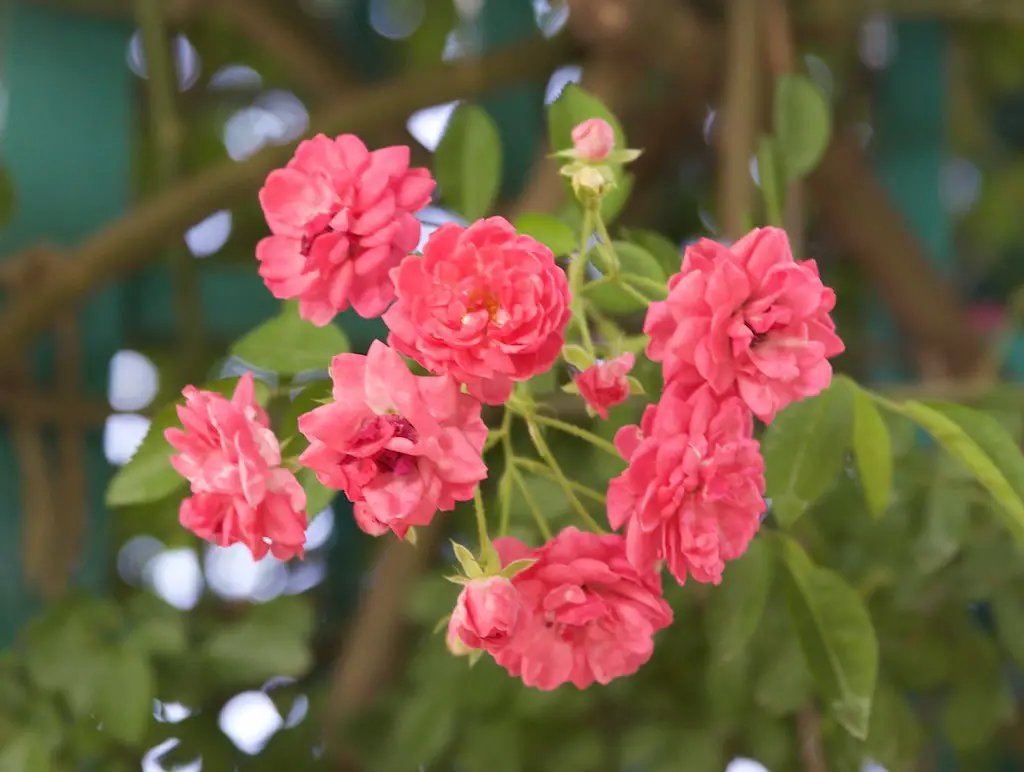The Peggy Martin Rose, named after its survivor Peggy Martin, is a true symbol of resilience and beauty. This remarkable climbing rose bush survived the devastating floodwaters of Hurricane Katrina in 2005. Since then, it has become a beacon of hope and an inspiring example of nature’s enduring spirit.
Renowned for its stunning, blush-pink blooms, the Peggy Martin Rose is a vigorous climber, known to adorn fences, walls, and trellises with an abundance of fragrant blossoms. The clusters of small, double-petaled flowers emerge in the spring and continue to grace gardens with their presence throughout the summer and fall.
This particular rose is not only celebrated for its visual appeal but also for its low-maintenance nature. The Peggy Martin Rose is disease-resistant and requires minimal care, making it a popular choice among both novice and experienced gardeners.
| Aspect | Details |
|---|---|
| Common Names | Peggy Martin Rose, Hurricane Rose |
| Botanical Name | Rosa ‘Peggy Martin’ |
| Family | Rosaceae |
| Plant Type | Climbing Rose |
| Mature Size | 15-18 feet |
| Sun Exposure | Full Sun |
| Soil Type | Well-drained soil |
| Hardiness Zones | 7-9 |
| Native Area | North America |
Peggy Martin Rose Care
Peggy Martin Rose Care is relatively straightforward, particularly due to the plant’s natural resistance to common rose diseases. It thrives in locations with plenty of sunlight and requires regular watering during its growing season. While it appreciates fertile, well-drained soil, it can also adapt to a range of soil types.
Proper pruning helps maintain the bush’s shape and encourages more prolific flowering. Annual fertilization will ensure steady growth and abundant blossoms. With the right balance of care and attention, the Peggy Martin Rose can be a stunning addition to any garden.
Light Requirement for Peggy Martin Rose
Peggy Martin Rose requires full sun, meaning it should receive at least 6-8 hours of direct sunlight daily. Proper sunlight promotes healthy growth, vibrant blooms, and helps prevent diseases. Position the plant in a location that provides abundant light for optimal development.
Soil Requirements for Peggy Martin Rose
This rose prefers well-drained soil but is adaptable to various soil types. Incorporating organic matter can improve drainage and add essential nutrients. A pH range of 6.0 to 6.5 is ideal, but the Peggy Martin Rose is known for its tolerance to diverse soil conditions.
Water Requirements for Peggy Martin Rose
Regular watering is vital, especially during the hot summer months. However, avoid overhead watering, as it may lead to leaf diseases. Drip irrigation or watering at the base of the plant ensures that the moisture reaches the roots without wetting the leaves.
Temperature and Humidity
Peggy Martin Rose thrives in moderate temperatures but can withstand hotter climates as well. In areas with high humidity, proper spacing and pruning are crucial to ensure good airflow, which helps in preventing fungal diseases.
Fertilizer
Fertilizing in early spring with a balanced rose fertilizer encourages strong growth and flowering. Follow the instructions on the fertilizer package for application rates and timing. Complementing with organic compost can further enrich the soil.
Pruning Peggy Martin Rose
Pruning is essential for shaping the plant and encouraging vigorous growth. Cutting back old, dead, or weak stems during late winter or early spring helps promote new growth and abundant flowering. Be sure to use clean, sharp tools to prevent disease transmission.
Propagating Peggy Martin Rose
Peggy Martin Rose can be propagated through cuttings. Taking a cutting from a healthy stem, ideally in early summer, and planting it in a pot with well-drained soil under proper conditions can lead to successful propagation.
How To Grow Peggy Martin Rose From Seed
Growing Peggy Martin Rose from seed is less common, as propagation through cuttings is usually more successful. If attempting to grow from seed, stratification and careful nurturing are necessary, although this method is often left to more experienced gardeners.
Common Pests & Plant Diseases
Aphids
Small insects that suck sap and can be controlled by neem oil or insecticidal soap.
Mildew
A common fungal disease that can be prevented with proper airflow and moisture control.
Common Problems With Peggy Martin Rose
Leggy Growth
Often due to insufficient sunlight. Ensure proper sun exposure for healthy, compact growth.
Yellowing Leaves
May be a sign of overwatering or nutrient deficiency. Assess watering practices and soil conditions to rectify the problem.
Lack of Blooms
Could be due to improper pruning or lack of nutrients. Consider proper pruning techniques and balanced fertilization.
Pro Tips
- Plant the Peggy Martin Rose in a location that provides ample space for growth, as it can become quite large.
- Use a trellis or support structure for the climbing branches to create an attractive display.
- Monitor regularly for pests and react promptly to signs of infestation or disease.
- Consider planting near other plants that attract pollinators, as Peggy Martin Rose is known to be a magnet for bees and butterflies.



